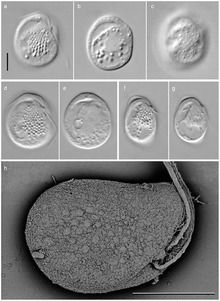| Roombia | |
|---|---|

| |
| Light (above) and transmission electron micrographs (below) of R. truncata | |
| Scientific classification | |
| Domain: | Eukaryota |
| Clade: | Diaphoretickes |
| Phylum: | Cryptista |
| Class: | Leucocryptea |
| Order: | Kathablepharidida |
| Family: | Kathablepharidae |
| Genus: | Roombia |
| Species: | R. truncata
|
| Binomial name | |
| Roombia truncata Okamoto et al. 2009
| |
Roombia truncata is a species of katablepharids, which are heterotrophic single-celled organisms.[1]
It was the first katablepharid to be generally available in cell culture, starting around 2009. The culture consists of Roombia, the diatom Navicula, and unidentified bacteria. Navicula provides the main food source for Roombia, although Roombia also feeds on the bacteria.[1]
Roombia was named after the Roomba robotic vacuum cleaner.[1]
References[edit]
- ^ a b c Okamoto N, Chantangsi C, Horák A, Leander BS, Keeling PJ (2009), Stajich JE (ed.), "Molecular Phylogeny and Description of the Novel Katablepharid Roombia truncata gen. et sp. nov., and Establishment of the Hacrobia Taxon nov.", PLOS ONE, 4 (9): e7080, Bibcode:2009PLoSO...4.7080O, doi:10.1371/journal.pone.0007080, PMC 2741603, PMID 19759916
External links[edit]
Well, that’s interesting to know that Psilotum nudum are known as whisk ferns. Psilotum nudum is the commoner species of the two. While the P. flaccidum is a rare species and is found in the tropical islands. Both the species are usually epiphytic in habit and grow upon tree ferns. These species may also be terrestrial and grow in humus or in the crevices of the rocks.
View the detailed Guide of Psilotum nudum: Detailed Study Of Psilotum Nudum (Whisk Fern), Classification, Anatomy, Reproduction